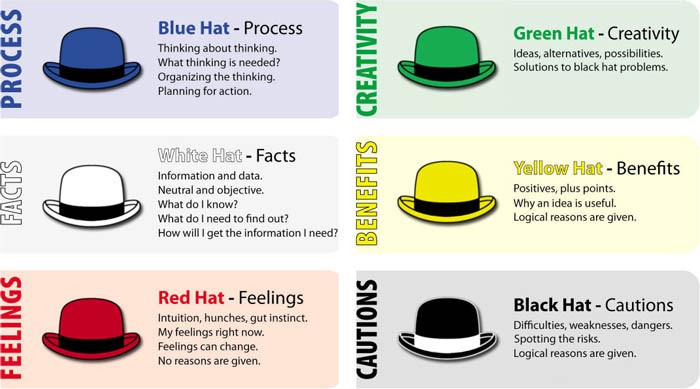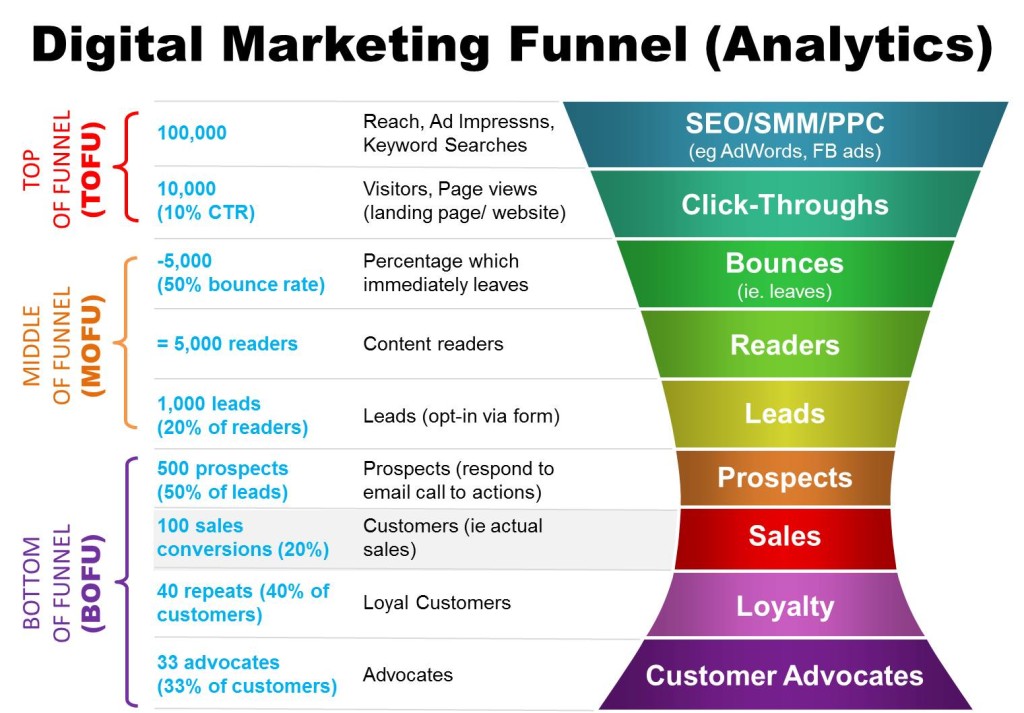
Wish to achieve better outcomes in social media marketing? Why not consider Edward de Bono’s Six Thinking Hats?
A cornerstone leadership and management strategy employed in organisations around the world, it fits beautifully into what we’re doing online.
Before we dive into how we can apply de Bono’s colourful hats online, let us first do a quick refresher on his time honoured critical thinking and brainstorming strategy.
Six Thinking Hats in a Nutshell
Affectionately termed by The de Bono Group as a “simple, effective parallel thinking process that helps people be more productive, focused, and mindfully involved,” Six Thinking Hats was originally designed for group brainstorming exercises back in 1995.
Using the process of wearing different coloured and symbolic “thinking hats” in a team discussions, participants are tasked to play different roles according to the coloured hats which they wear:
- White Hat – Calls for information and facts needed. “The facts, just the facts.” Think of a white paper full of facts, figures and data (or a scientist in a lab coat.)
- Red Hat – Like the colour of the heart, the Red Hat is about feelings and emotions. This is where you go with your gut, and use intuition to express your fears, likes, dislikes, loves and hates.
- Yellow Hat – Representing brightness and optimism, Yellow Hatters are bright-eyed and bushy-tailed. Wearers of this hat should explore the positives and benefits of an idea.
- Black Hat – The opposite of the Yellow Hat, wearers of the Black Hat plays the devil’s advocate. Your role is to poke holes at arguments, spot difficulties and dangers, and identify possible risks.
- Green Hat – Like a garden blooming forth, the Green Hat represents creativity, possibilities and new ideas. Wearers will imagine new ideas, novel concepts and fresh perspectives.
- Blue Hat – Also known as the “boss hat,” this is the hat that manages the thinking process. Your job here is to organise all the other hats and ensure that there is a systematic outcome from the discussion.
Here’s a useful chart showing how these hats work (courtesy of Thiago Carvalho on Medium).

With the Six Thinking Hats at the back of your mind, let us now put on each hat and consider them from the perspective of social media marketing.
N.B. – Note that the terms “white hat” and “black hat” are commonly used in Search Engine Optimization (SEO) to mean ethical (White Hat SEO) and unethical (Black Hat SEO) link building strategies. These are different from how I’ll be presenting them here.
#1 White Hat – Objectives, Metrics, and Analytics
When you put on your White Hat, you’re looking at data, facts and figures.
Like any other pillar of digital marketing, social media marketing allows you to track, monitor and analyse your numbers. By using free social media analytics tools, you can measure your exact performance and benchmark against what your competitors are doing.
To measure your social media performance, get a handle on the following metrics:
- Awareness/reach: page views, visitors, reach, no of fans/followers
- Engagement: “likes”, comments, shares, retweets, reposts
- Conversion: opt-ins, sign-ups, downloads, subscriptions, and purchases
- Loyalty and Advocacy: fan shares, retweets, fan blog posts, influencer posts, hashtagged posts
Map them all together on your digital marketing funnel to get an idea of where your social traffic goes to, and how effective your lead generation and conversion tactics work.

#2 Red Hat – Emotional and Psychological Triggers
In the world of social media marketing, emotions play a huge role in driving decision making.
According to Jonah Berger in his STEPPS framework, high arousal emotions can trigger social sharing. Use these in your content to generate greater Word Of Mouth (WOM):
- Amusement: Humour is the top reason for people to share stuff
- Anger: Donald J Trump is an expert in this!
- Anxiety: When we worry, we share
- Awe: When we’re bowed over by a video or a photo, we share!
- Adrenalin (ie exciting): Seat gripping action gets us sharing
Beyond social sharing, we should also take note of the 7 triggers of fascination conceived by Sally Hogshead:
- Lust: This applies not just to sex appeal but in any post catering to human desire (eg eating, traveling, living in luxury)
- Mystique: We are drawn to the mysterious and enigmatic
- Alarm: Also known as the scarcity trigger, this is one of the most used emotional trigger
- Prestige: Especially useful for luxury or status giving products
- Power: Not just for men and women in suits, people are drawn to others with authority
- Vice: Somehow or other, we are drawn more to naughty than nice
- Trust: Conversely, giving others a sense of trust increases our standing considerably
#3 Yellow Hat – Benefits, Gains and Positiveness
In a world full of darkness and despair, a ray of sunshine can make us feel good.
Likewise, consider incorporating positive messages and helpful elements in your social media content and campaign ideas. Begin by providing positive content that uplifts the spirit of your community and gives them hope.
Jay Baer certainly knows the value of positive content. Author of Youtility, he preaches a form of content marketing which looks at offering…
“… massively useful information, provided for free, that creates long-term trust and kinship between your company and your customers.” – Jay Baer
Examples of smile-inducing content may include the following:
- Articles offering tips, tactics and techniques to help your community do better
- Templates and checklists that are useful for businesses to follow
- Videos which help to troubleshoot common problems and issues
- eBooks and guides that address more complex challenges and issues
- Edutaining and enriching content that nourishes the spirit and refreshes the soul
#4 Black Hat – Risks, Dangers and Mistakes
To marketers, telling your prospective customers of the dangers of your products or services just doesn’t sound right. After all, you do want to make a sale and not scare them away.
Well, in an increasingly volatile and uncertain world, people will flock to those whom they trust. And trust is often built through honest and transparent sharing of knowledge and experiences.
I’ve done my fair share of “negative” content, and they include the following:
- Frequent mistakes that you should avoid in social media marketing
- Examples of social media marketing failures
- Errors that you could commit in content marketing
- Wrong ways to implement marketing automation in your organisation
Beyond content warning others of their errant ways, do also consider your own mistakes. Adopt a critical eye when you analyse your data, and do not be afraid of trials and errors in rolling out your plan.
#5 Green Hat – Creative Ideas and Artistic Flair
Social media marketing requires loads of Green Hat creativity.
While you can try to growth hack your competitor’s content and embrace newsjacking as a way to get noticed, you still need to inject creativity and artistry to stand out from the crowd.
According to my favourite creativity guru Elizabeth Gilbert, creativity thrives under curiosity – not passion. The best way to trigger creativity is to think like a trickster (think Loki instead of Thor), embrace playfulness, and to be light and unburdened.
Creativity in content also comes from embracing chaos and accidents, becoming a rebel, breaking the rules, and following your heart. Take a break from your laptop, walk in your neighbourhood for a bit, and talk to a random stranger.
Expose yourself to serendipitous encounters. Who knows, you’ll be able to find your answers there.
#6 Blue Hat – Managing Social Media Marketing
Last, but certainly not least, social media marketing is a management process.
If you imagine that social media influencers are spontaneous content machines, you are wrong. Many of the top bloggers and Instagrammers around the world have a systematic and well-orchestrated process of creating content, sharing them on their networks, and monitoring their analytics.
As a social media marketer, you need to also embrace the best practices in community management. Read my article on the best practices in community management – you’ll learn how to recruit and engage social media fans, sustain their long-term interest, and encourage advocacy.
Finally, consider the importance of a social media calendar. As the saying goes, “Whatever gets written, gets done.” Establish a schedule for your content and ensure that they are systematically published and shared throughout the weeks, months, and years.
Conclusion
In the hyper competitive and dog-eat-dog-world of social media marketing, you’ll need to harness a wide variety of perspectives and insights in order to succeed.
Adopting Edward de Bono’s Six Thinking Hats framework helps you to think more expansively while ensuring that critical ideas, concepts and approaches are not omitted.
If you do have a team to work with (lucky you), it makes sense for your individual team members to wear different coloured thinking hats as you brainstorm and conceive social media strategies and tactics. As the leader (and hence the blue hat wearer), your job would then be to sum up all the key points, crystallize them into action steps, and put in a place a rigorous process of implementation.

One Comment